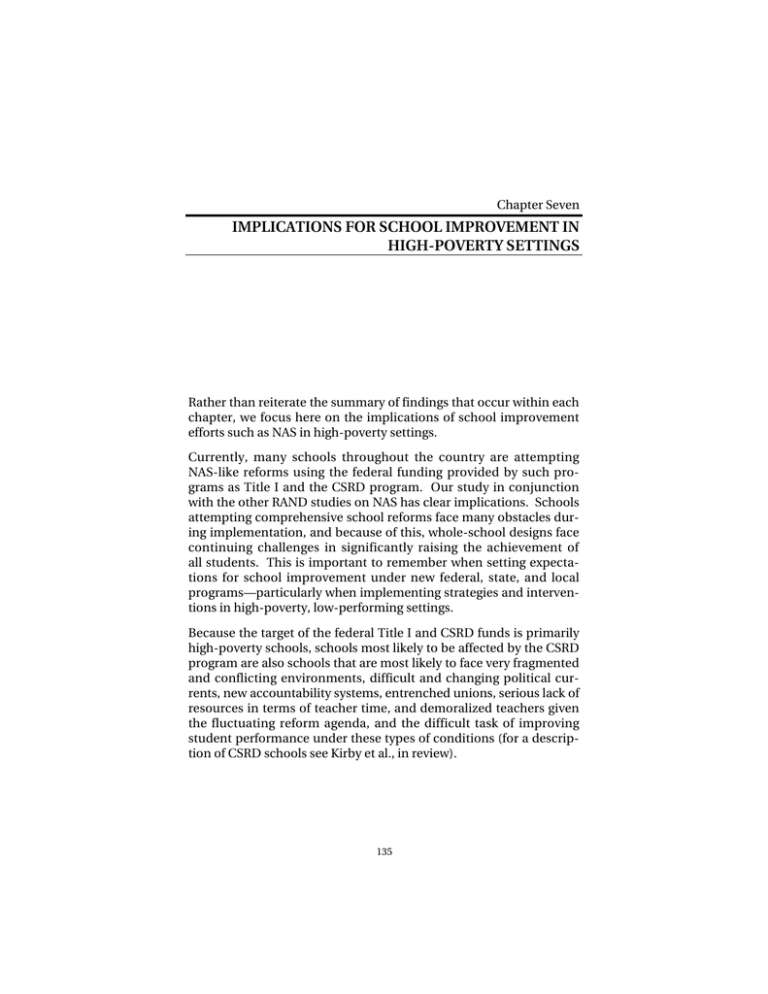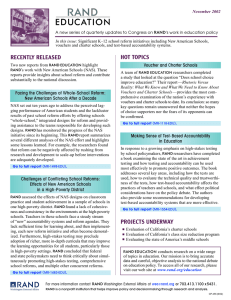IMPLICATIONS FOR SCHOOL IMPROVEMENT IN HIGH-POVERTY SETTINGS
advertisement

Chapter Seven IMPLICATIONS FOR SCHOOL IMPROVEMENT IN HIGH-POVERTY SETTINGS Rather than reiterate the summary of findings that occur within each chapter, we focus here on the implications of school improvement efforts such as NAS in high-poverty settings. Currently, many schools throughout the country are attempting NAS-like reforms using the federal funding provided by such programs as Title I and the CSRD program. Our study in conjunction with the other RAND studies on NAS has clear implications. Schools attempting comprehensive school reforms face many obstacles during implementation, and because of this, whole-school designs face continuing challenges in significantly raising the achievement of all students. This is important to remember when setting expectations for school improvement under new federal, state, and local programs—particularly when implementing strategies and interventions in high-poverty, low-performing settings. Because the target of the federal Title I and CSRD funds is primarily high-poverty schools, schools most likely to be affected by the CSRD program are also schools that are most likely to face very fragmented and conflicting environments, difficult and changing political currents, new accountability systems, entrenched unions, serious lack of resources in terms of teacher time, and demoralized teachers given the fluctuating reform agenda, and the difficult task of improving student performance under these types of conditions (for a description of CSRD schools see Kirby et al., in review). 135 136 Challenges of Conflicting School Reforms Given this, federal and state policymakers need to think critically about their current stance of simultaneously promoting: high-stakes testing; the implementation of comprehensive school reforms that promote innovative curriculum and instructional strategies; and the implementation of multiple concurrent reforms. The implementation of high-stakes testing regimes—the apparent outcome of many standards-based reforms—might preclude the adoption of rich and varied curricula that challenge students and motivate them toward more in-depth learning experiences. It certainly prevents adoption of such curricula when other reforms emphasizing only basic skills instruction are mandated on top of the design-based curriculum. The current study shows that high-stakes tests are a two-edged sword in this environment. On the one hand, high-stakes tests motivate schools to increase performance and often to seek out new curriculum and instructional strategies associated with comprehensive school reforms. On the other hand, those very same tests provide disincentives to adopt richer, more in-depth curriculum. TOWARD BETTER EDUCATIONAL POLICY Our findings are consistent with Porter and Clune’s scheme for better educational policy (Porter et al., 1988; Porter, 1994; Clune, 1998). They posit that educational policies such as comprehensive school reform are likely to influence teachers and students to the extent to which they are specific, powerful, authoritative, consistent, and stable. Specificity, or depth, is the extent to which the comprehensive school reform provides detailed guidance or materials to help schools and teachers understand what they are supposed to do (e.g., materials that describe the stages of implementing the design and ongoing, clear assistance strategies to further promote implementation). Power refers to the rewards or sanctions attached to the whole-school reform, such as teachers receiving bonuses or greater autonomy if they comply with implementing the design. Authority refers to the degree to which the reform policy is seen as legitimate and as having the support of those who are responsible for implementation. If respected groups or policymakers have strong positive views toward whole-school reform and if teachers support its implementation, the design is likely to have greater influence in changing teaching and learning. Consistency or alignment refers to the extent to which the set of whole-school interventions and strate- Implications for School Improvement in High-Poverty Settings 137 gies are aligned with a common mission and vision, both within the school and the district. Stability refers to the reform being sustained over time in a coherent, consistent manner. Policymakers and educators should use these dimensions as a means for thinking critically about the comprehensive school reform being considered and whether the conditions exist for it to flourish. Specificity In the case of San Antonio, the specificity of the designs varied as did the detailed guidance provided by the district and design teams. The district was supportive of the designs and promoted their adoption throughout the district. In addition, the district devoted a great deal of financial resources and professional development to schools and teachers to change the learning environments for San Antonio students. Yet, over time, the specificity of the mathematics and reading initiatives far outweighed the specificity of the designs. As shown by interviews and observations, for example, elementary school teachers were expected to be within a certain page of the Everyday Mathematics workbooks, and district staff conducted checks in schools to ensure this was happening. Because of the structure of these other initiatives and the time that such prescriptiveness took, there was little time left over for design team activities, no matter how specific those may have been. Moreover, about a third of the NAS teachers in our longitudinal teacher sample reported that the lack of coherent, sustained professional development hindered their students’ success. About 15 percent of non-NAS teachers reported such a hindrance. This contrast suggests that the specificity of the district’s professional development strategies for the mix of reforms was overwhelming to NAS teachers, who were implementing the entire set of reforms in the district. Even the design teams themselves differ in the level of specificity that they provide schools. On the one hand, SFA/RW provides specific training and materials to schools to structure the reading program for elementary-level students. In addition, assessments are provided to ensure that grouping arrangements remain flexible and students can move every six to eight weeks or every grading period to a new group, if necessary, that meets their educational needs. On the other 138 Challenges of Conflicting School Reforms hand, ELOB offers little specific curricular guidance, providing teachers with learning principles and an emphasis on project-based learning. It is up to the teachers to develop the curriculum for the learning expeditions and all the units that comprise them. As we found across all the designs, teacher training declined over time, and the design team representatives had less contact with schools and teachers over the course of this study. However, teachers desired more design team training to better understand the components and activities of the designs. They reported the need for more concrete, hands-on training that would enable them to better understand design processes and activities. Power There were very few rewards and sanctions associated with the NAS designs in San Antonio. While the superintendent had desired to have NAS designs be the integrative force to hold the district’s reform efforts together, there were few rewards or sanctions for schools and teachers to adopt and implement the NAS reform. The stronger rewards and sanctions were associated with the TAAS, not with implementation of the designs. NAS designs were merely a weak tool that the district employed to bring about school change. As was clearly evident by the 1998–1999 school year, the district had invested more energy in its mathematics, reading, and language arts initiatives. Certainly, it was these that had more power for schools and teachers, not the NAS designs. Thus, if districts and schools want to have whole-school reforms take hold in schools and be sustained over time, they will need to attend to the rewards, sanctions, and incentives associated with the reform. More important, they will need to attend to the rewards and sanctions linked to other reforms and assessments to understand whether implementation of whole-school reforms is in conflict or supported by the power of other reforms. Authority During the time of this study, NAS and its designs were all seeking greater authority. At the time of this study, only the SFA program Implications for School Improvement in High-Poverty Settings 139 had been noted as significantly improving students’ test scores (see Herman et al., 1999). While there was some achievement evidence coming out of Memphis (see Ross et al., 2001), this work had not yet been published in a peer-reviewed journal and was specific to one jurisdiction. As our interviews with teachers and district staff revealed, the district had hoped that NAS and its designs would be the glue to hold the district together. However, there were doubts about whether the designs could raise students’ TAAS scores to the extent necessary to meet the state accountability requirements. Hedging its bets, the district added specific curricular programs to the mix of reforms, which in the end, pushed the NAS designs to the periphery of the everyday lives of students and teachers in classrooms. To some degree, the lack of authority associated with the NAS reform in San Antonio may have led to a lack of teacher support for the designs. We found that teacher support for the designs declined from 54 percent in 1998 to 25 percent in 1999. In interviews, teachers expressed that they doubted whether the NAS designs alone helped their students build an academic foundation, which so many of them were lacking. Over time, as some designs establish more of an evidentiary base for their practices and approaches, such authority will appeal to schools and districts. If designs and districts can integrate professional development and training over time, it is likely that ongoing support of teachers can be sustained rather than wane. Coherence and Alignment The policy of the NAS reform was not well aligned with the districtmandated initiatives. The district, schools, and teachers were aware of this—a pressing question with which all were struggling. In fact, during the time of our study, the district was pursuing how the NAS designs could be integrated with the mathematics, reading, and language arts frameworks it had put forth. This was certainly a difficult issue within the high-stakes environment. Yet, while the district and teachers were living with this question, life in classrooms reflected that by the spring of 1999, fourth grade stu- 140 Challenges of Conflicting School Reforms dents spent half of their day on a very specific mathematics program and tightly structured reading and language arts frameworks. Clearly, district-issued curriculum and instructional strategies limited the ability of teachers to develop units, plan expeditions and lessons, and engage in instructional practices described in the NAS and design team literature. It was the district and state initiatives that directed the educational mission of all schools in San Antonio, not the NAS designs. Further integration and forethought on behalf of districts and schools to integrate their reform strategies and interventions is a challenge in many environments, particularly high-poverty, lowperforming ones. Yet, it is critical to align the reform policies, strategies, interventions, and supports for meaningful school improvement that continues over time. Stability After the data collection efforts for this study ended in the spring of 1999, a critical moment occurred—the superintendent’s departure— followed by the decline of the NAS initiative in San Antonio.1 As so often happens in urban school districts, the superintendent’s position was tenuous with the school board. After a school board election in May, 1999, two new board members were elected—thus tipping the balance of the school board against her. Soon after, the superintendent accepted a generous buyout and resigned. Her resignation was accepted by a 4-3 vote by the school board. Her success in improving the test scores in San Antonio schools relative to the state, even though still lagging far behind, assured her a position elsewhere. She moved on. The stability of the NAS designs in San Antonio was deeply affected by the superintendent’s departure. During the summer of 1999, teachers were asked to vote whether or not to keep the designs. Whereas some schools initially adopted designs based on 60 percent of their teachers voting in favor of adoption, the summer 1999 vote required 80 percent of the teachers to vote in favor of keeping the ______________ 1This information is based on interviews with district staff and some design teams after the superintendent’s departure as well as reports in the San Antonio Express-News. Implications for School Improvement in High-Poverty Settings 141 design. The lack of support that existed in NAS schools, the overburdening that NAS teachers reported, and the uncertainty and tension within the district likely led to the substantial number of schools that voted to drop the designs. The stability of the whole-school improvement efforts with NAS designs thus was on very fragile ground, even in a district that was initially so supportive of NAS implementation. Unfortunately, such instability is all too common in high-poverty settings. To put the policy pieces having the qualities mentioned here in place for reform, and to sustain them over time despite the changes in leadership, remains a significant challenge. SCHOOL LEADERSHIP In addition to the importance of district leadership in implementing policies that are specific, powerful, authoritative, aligned, and stable, the leadership in schools is also critical. Despite all that was going on in the district and the overall similarity of instructional conditions, our analysis showed that principal leadership had a strong effect on student achievement scores. Controlling for other student, teacher, classroom, and school factors, classrooms in which teachers reported greater principal leadership had higher TAAS reading and mathematics scores by 0.15 and 0.21 of a standard deviation, respectively. Principal leadership in our analysis was measured by teacher reports about principals who clearly communicated what was expected of teachers, were supportive and encouraging of staff, obtained resources for the school, enforced rules for student conduct, talked with teachers regarding instructional practices, had confidence in the expertise of the teachers, and took a personal interest in the professional development of teachers. Our previous analyses have shown the importance of principal leadership in implementing the designs (Berends and Kirby et al., 2001; Kirby et al., 2001), so the link between implementation and performance is likely to be important as more and more schools adopt comprehensive school reform. Therefore, the importance of principal leadership should not be overlooked when adopting and implementing whole-school reforms. 142 Challenges of Conflicting School Reforms SUPPORT FOR SCHOOLWIDE REFORM Our analyses show that the design teams had a difficult time in San Antonio because of the high-stakes accountability environment, the pressing need to improve test scores, and the lack of the qualities— depth/specificity, power, authority, consistency/alignment, and stability—of the policies directly related to design implementation. We have argued that the implementation of designs in classrooms was affected by factors related to district, schools, teachers, and design teams. The findings here are consistent with what RAND has found in its other studies of NAS (Kirby et al., 2001; Bodilly, 1998; 2001; Berends and Kirby et al., 2001; Berends, 2000; Bodilly and Berends, 1999). Comprehensive reforms face many obstacles during implementation, and because of this, whole-school designs face continuing challenges in significantly raising the achievement of all students, particularly those in high-poverty settings. The key seems to be implementing the reform in such a way that it aligns with the other school reform efforts to ensure consistent implementation over time. The challenge for such improvement efforts to become schoolwide looms large in the current environment where leadership in high-poverty districts and schools is fragile and unstable, fraught with conflicting policies and reform efforts. As policymakers and practitioners, we must continue to grapple with the questions: How can the designs become schoolwide? How can we shape policies related to comprehensive school reform to lead to meaningful school improvement efforts? What supports—of states, districts, design teams, and schools—are necessary for implementation to take hold and be sustained over time? We have attempted to shed some light on those critical aspects of policies that policymakers and practitioners can address when embarking on whole-school reform efforts. Time will tell whether districts, schools, design teams, teachers, and NAS can make the appropriate adjustments in the implementing sites. Additional and more specific longitudinal achievement data over time will help assess the conditions under which design-based assistance can contribute to improving student performance. However, as this study has emphasized, it is critical to understand the local conditions in which whole-school reforms operate. Researchers Implications for School Improvement in High-Poverty Settings 143 need to understand the district reform policies and how principals and teachers within schools enact these reforms. Moreover, when comparing those schools that are implementing reforms with schools that are not (the “control” schools), understanding what actually is being implemented in the comparison schools sheds important light on our understanding of the entire reform effort. In highpoverty settings, then, it is as important to understand reform efforts in the “control” schools as it is in the “treatment” schools to provide a more comprehensive assessment. Continued research is critical, then, for understanding what it takes to sustain reform efforts such as NAS and other comprehensive school reforms. If teachers, principals, designs, and districts can sustain their focus on the NAS designs to structure the educational policies and their enactment in schools and classrooms, it is likely that the designs will become not only more widespread across schools, but also deeper in their implementation within schools. Perhaps, they may even be sustained over a longer period of time. However, accomplishing that goal will involve better policy, more perseverance, and leadership at all levels.



